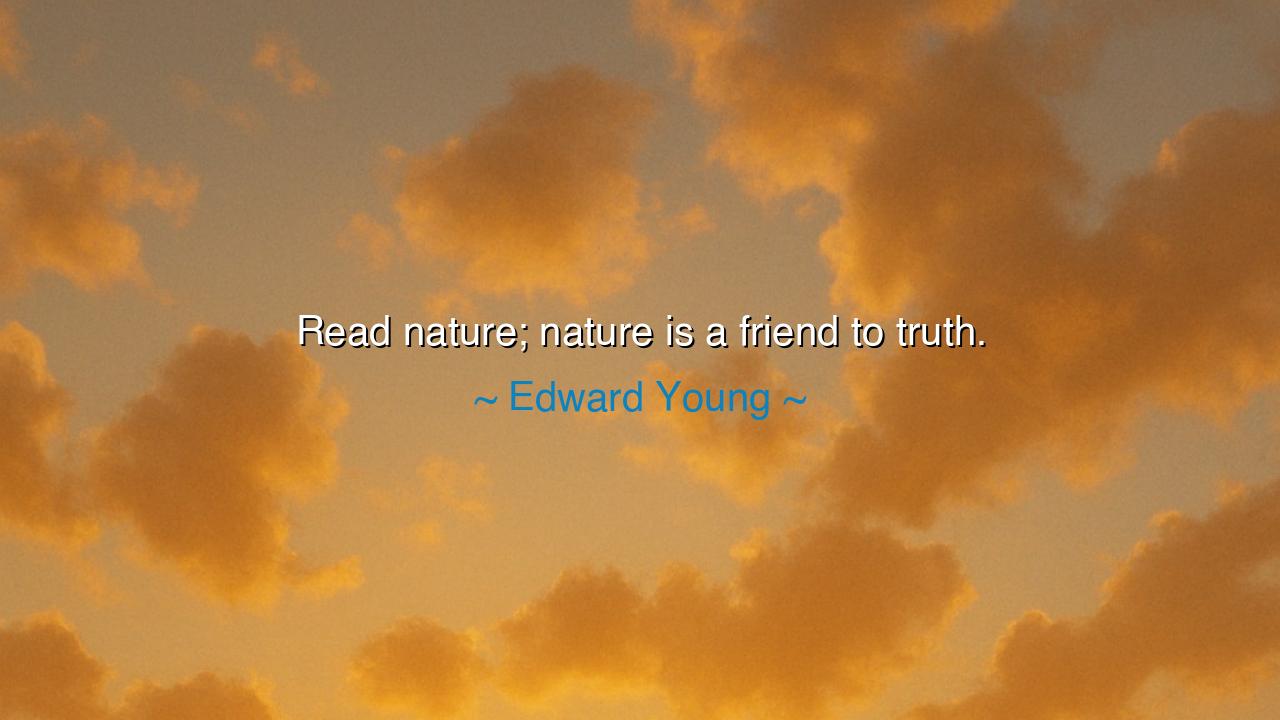
Read nature; nature is a friend to truth.






Hear now the words of Edward Young: “Read nature; nature is a friend to truth.” These words flow like a river from the heart of wisdom, calling us to look beyond books, beyond theories, beyond the noise of men, and to attend to the eternal scripture written in the sky, the sea, the mountain, and the leaf. For the ancients knew — and Young reminds us — that nature is not silent. It speaks with a voice that does not lie, a voice uncorrupted by vanity or ambition. To read nature is to turn the pages of creation itself, and to encounter the divine truth written into its order.
The truth of nature is not fashioned by human hands. Empires rise and fall, philosophers argue, doctrines shift, but the stars still course across the heavens, the rivers still carve valleys, the seed still grows into the towering oak. In nature, one sees the laws of existence that no king can alter and no decree can silence. To read these laws is to anchor oneself in that which endures. This is why the prophets retreated to deserts, the sages to mountains, and the poets to the solitude of fields — for in the presence of nature, truth reveals itself not in words, but in silence and order.
Consider Galileo, who dared to lift his glass to the heavens and read nature for himself. Others clung to traditions and dogmas, but Galileo let the moon, the planets, and the stars teach him. What he saw could not be denied: moons orbiting Jupiter, imperfections on the lunar face, truths that shattered falsehoods long held. By reading nature, he discovered reality; by befriending truth, he altered the destiny of mankind. Though condemned by men, he stood with the cosmos itself — and what greater ally can one claim than nature, the faithful friend of truth?
The ancients of the East also bore witness to this wisdom. Lao Tzu, gazing upon rivers, taught that truth is found in yielding like water, which conquers by softness. The Buddha, meditating beneath the Bodhi tree, found enlightenment not in debate, but in stillness beneath the canopy of nature. The Psalms of David cry out with the same vision: “The heavens declare the glory of God.” Across cultures, across centuries, the refrain is the same — nature does not deceive; it is man who deceives himself when he refuses to listen.
But Edward Young’s words are not merely lofty ideals — they are instruction for the living. When life feels confused, when falsehood clouds the air, step into the forest, or stand by the shore, or lift your gaze to the constellations. There, the petty noise of men grows quiet, and the greater harmony reveals itself. A tree does not pretend to be what it is not; the tide does not hide its coming and going. So too should we live in such truth — steady, open, unmasked.
The lesson then is clear: if you seek truth, do not confine yourself to the libraries of men alone, but walk also in the library of creation. Read nature daily, as one would a holy book. Study its patience, its cycles, its balance. Learn from its storms and from its blossoms alike. For in every gust of wind, in every stone upon the path, in every star at midnight, there is a letter written in the great alphabet of existence.
Practically, take time to step outside, to walk with no other purpose than to observe. Watch the sunrise and learn renewal; watch the mountain and learn steadfastness; watch the stream and learn resilience. Let these lessons settle into your soul until they shape your actions. When confusion tempts you, remember: nature does not flatter, nor lie, nor seek to please — it simply reveals.
So let Young’s words be carried in your heart: “Read nature; nature is a friend to truth.” For in a world clouded by falsehoods, where voices multiply and confusion abounds, the earth still speaks with the clarity of ages. Bend your ear to its wisdom, open your eyes to its lessons, and you shall walk not in illusion, but in the companionship of eternal truth.






AAdministratorAdministrator
Welcome, honored guests. Please leave a comment, we will respond soon